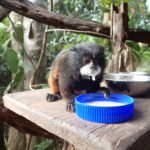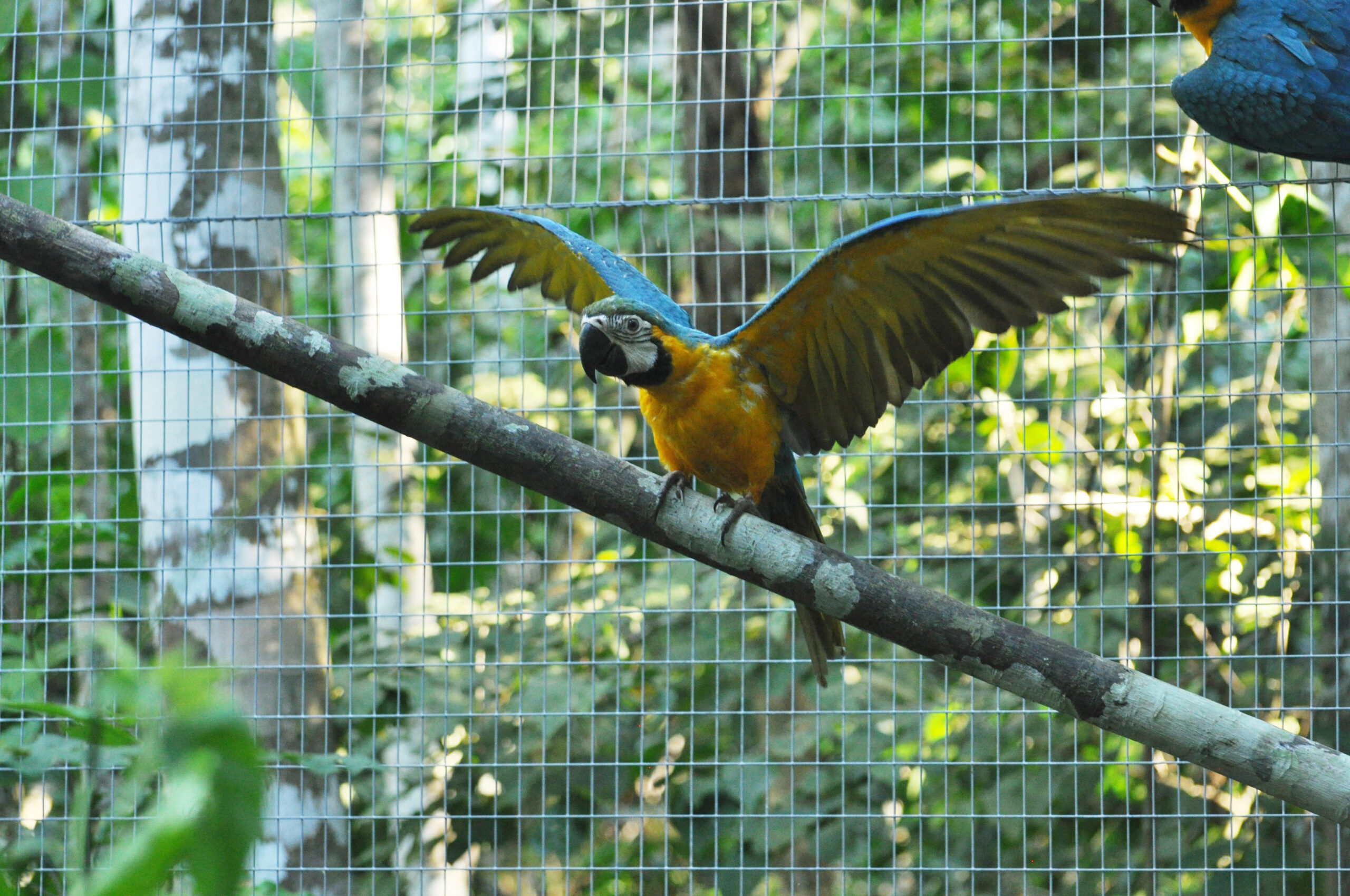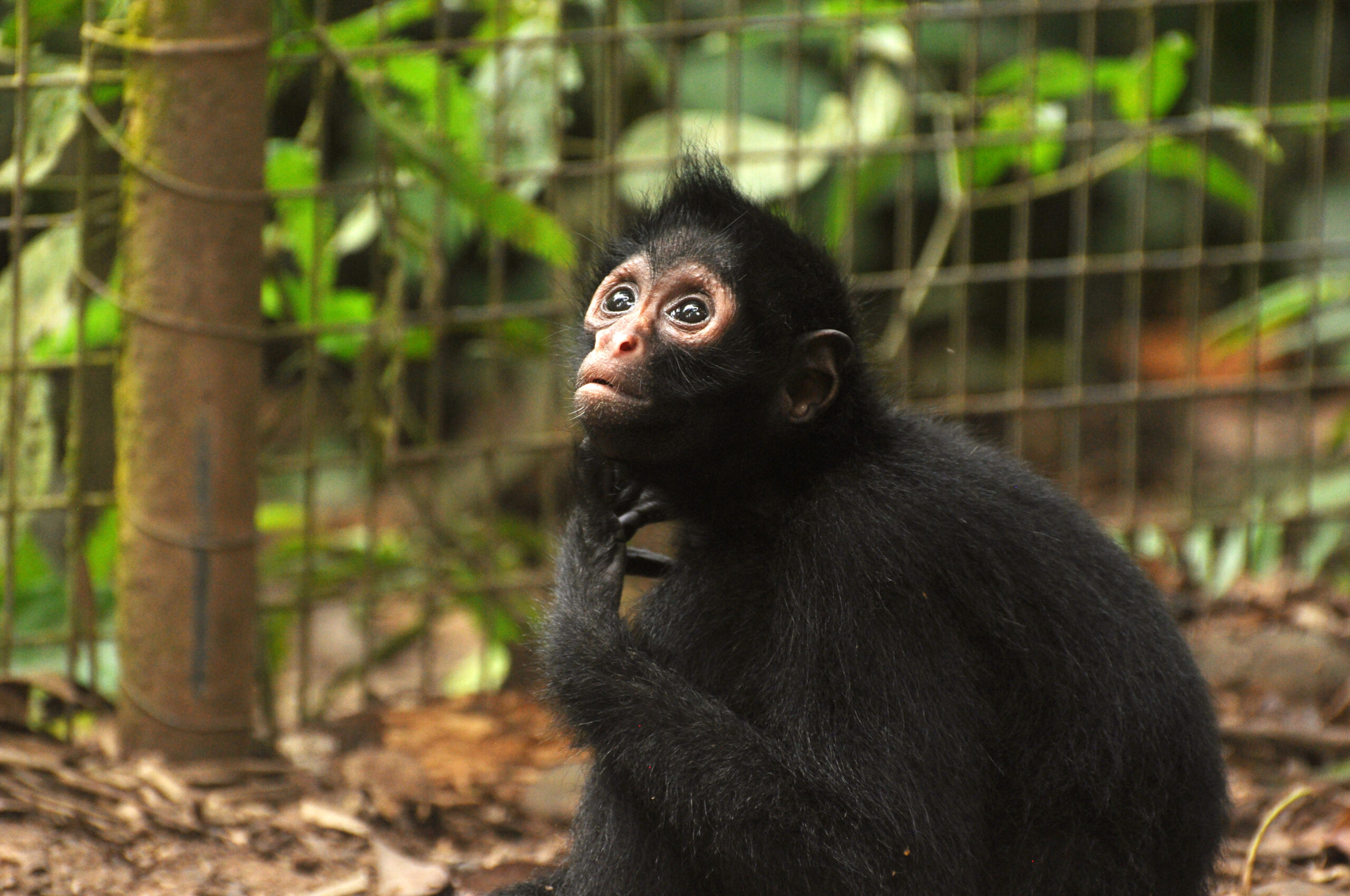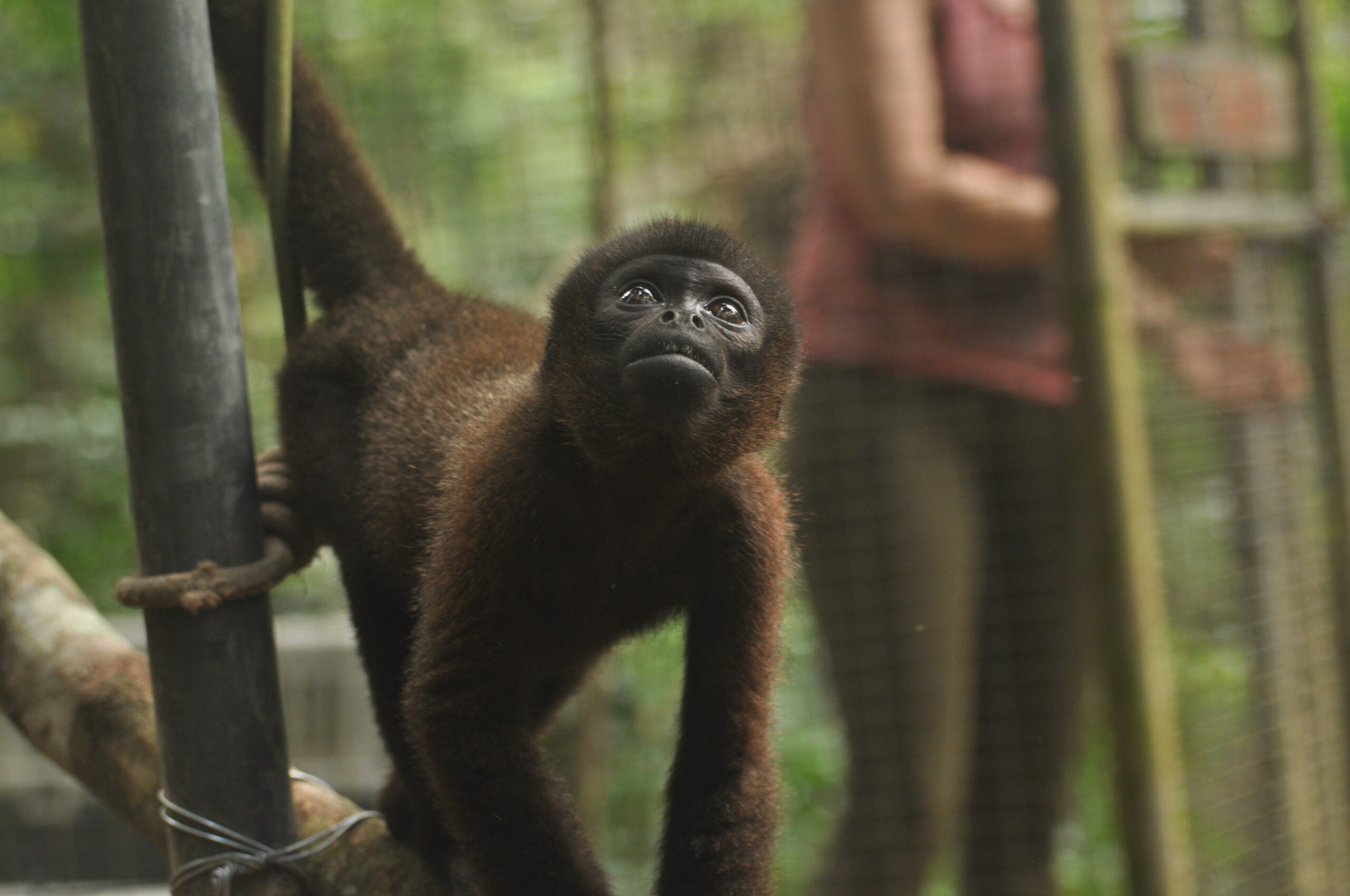June was the month where cages were filled as fast as they were emptied. Thankfully the entire team was up to the challenge with 13 new animals arriving throughout the month. Creative animal management was the key to ensuring everyone was secure in the best environment to suit their needs.
 Monkeys
Monkeys

This month saw Ramon and Darwin (male howler monkeys) move from their long term residence in Pepe enclosure, to the Roko enclosure, using it as a place to sleep in the evenings after a hard day of freedom playing with the other baby monkeys. There they joined Yuria (female Equatorial Saki) who was moved there from the clinic. Yuria seems quite relaxed about it all and primarily keeps to herself. Armando (youngest male howler monkey) also joins Yuria for a little time each day. The idea is he will slowly get more used to being with monkeys instead of hanging on to humans. However this process cannot be rushed as too much pressure could have the opposite effect and make Armando less enthusiastic about leaving the security of his caretaker. Baby steps are the key.
Tonka (male Andean Saddleback Tamarin) has moved and left the clinic for the outside enclosure Lucia. With him now outside and the fantastic calls you can hear him making, we hope this will soon encourage some interest from a wild troop of Tamarins.
 Other Animals
Other Animals
Mokwai and Rumani (crab eating racoons) were also moved from La Sapa to Pepe. We really hope you can keep up with all the changes; it’s a very common occurrence at a rescue centre! We had to make room for the monkey group from the clinic (see new arrivals), so we would be ready for new comers in need of rescue. Soon we will hope to have more time to take them on some well deserved outside walks.
June was an exciting month for our opossums. Cia had three babies and if that wasn’t enough, not only did they get a new home they also got the chance at release.
Two large cages were set up and then joined together in a tree in the plantation. After a week of getting comfortable with the new location, the doors were opened in the evenings. Initially Rubai was the only one to fully embrace the freedom and has not been seen since. Cia now disappears for a few days at a time and Aeris appears quite happy to come and go as she pleases, although she is always home for her evening meal, which is still diligently supplied by our team.
The new Elmo enclosure is finally seeing its full potential, with the seven blue and yellow macaws being transferred from the front cage to now roam freely throughout the full enclosure. It was slow going initially with the birds unwilling and uncertain about their new found space, but surely enough, once one led the charge the others were quick to follow.
For those volunteers fortunate enough to participate in the ‘release’, it was a moment to be cherished, savouring a moment that so many had worked tirelessly towards. These birds will never be returned to the wild as they were removed from the nest too young to know how to survive, but through the efforts of EV team they will be given the next best thing. These birds will now have the chance to interact with their own species freely and be surrounded by their natural habitat.
With the front cage of Elmo now free, it was a great opportunity to get everyone’s favourite blue and yellow macaw out of the clinic and back out into the open. Rafiki made the move with very little hassle and appears to be adjusting well. Plenty of interest was shown both ways between the seasoned veteran and the younger birds and it looks like they will all make very good neighbours. Rafiki won’t be able to join them in the big enclosures as there is too big of a risk of falling from a height, as unfortunately he can’t use his wings at all.
From the day they arrived in March, the white-winged parakeets have been a roller coaster ride of emotions, testing peoples will, and often making volunteers wonder if they were making a difference. To everyone who has ever had that thought, I really wish they could have been at EV this month. This month saw the remaining parakeets undergo a flying assessment to ascertain which individuals were suitable for release. They were later given a final dose of anti-parasite medication to prepare them for release. For the strongest flyers it was time to move to the Aquatena (at the new quarantine site) as a special hatch had been installed to allow the birds to leave as and when they felt comfortable. Seeing the birds leave their transport boxes was a sight to behold. Prior to their arrival, all these birds had had their feathers cut when they were captured, so seeing them fly at full strength again was confirmation that our hard work had paid off. After a day or so in Aquatena all birds had left and it was time to move on to assessing the next group.
Seeing and hearing parakeets flying around freely is now a common occurrence on site and although we can’t guarantee all of them will survive in the wild, the smiles on the people who have worked so hard to give these beautiful animals a second chance speaks volumes. There can be no doubt, YES we are making a difference!
 SUST Animal Orphan Hospital
SUST Animal Orphan Hospital
You will have surmised from the above that the SUST Animal Orphan Hospital was busy all month and this culminated in the final few days of June with the another nine animals arriving on the last Thursday of the month.
Sayani, and Mayla (orange winged amazon parrots) are still in the clinic and are both being treated for different eye conditions. We are still hopeful that they can both join the other birds in the Igor cage soon.
 New arrivals
New arrivals
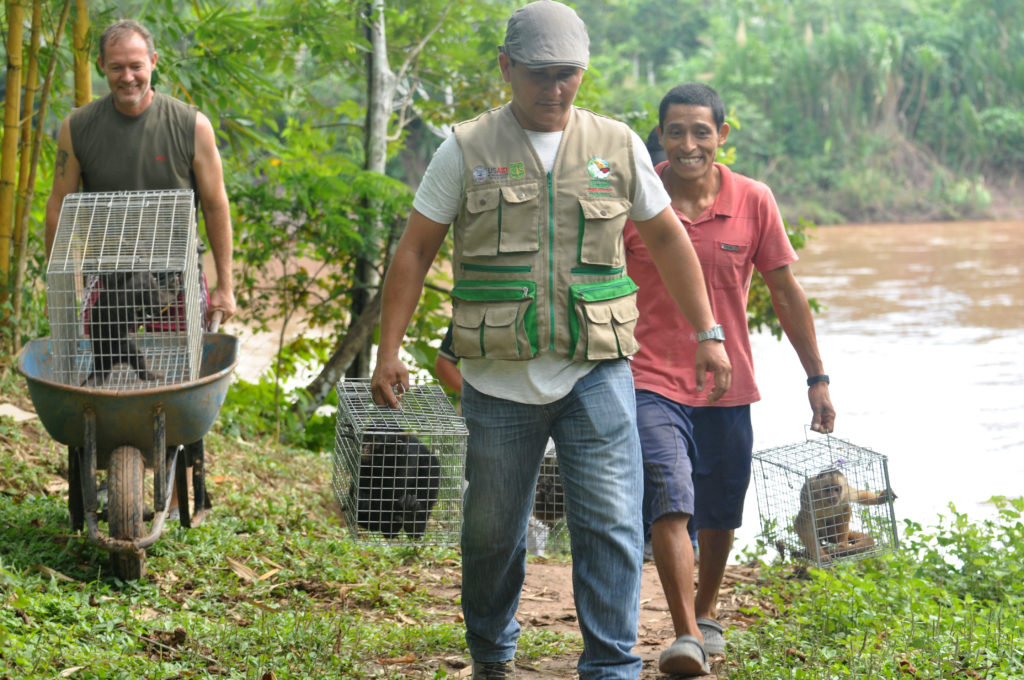
Tandoori, a female tamandua or lesser anteater, showed up in a garden in the suburbs of Pucallpa and the Ministry was called to pick her up. She was taken care of for some time by a veterinarian in Pucallpa and it seems she had been used to people and had likely been in captivity before that. She was placed in the Tiliku cage, as Kiko and Kila (our male and female kinkajous) had not been using it that frequently, and are now fed on an outside table. She is receiving fresh termites daily as well as a power mix made by Olivia twice a day. Her strength and enthusiasm is coming ahead in leaps and bounds which is hugely positive as the aim is to release her as soon as she is strong enough.
Cesar (male spider monkey) and Nando (male white capuchin) were raised from a baby by a woman living in Pucallpa and then were later confiscated by the Ministry. Apollo (male large headed capuchin) was found on the streets. At first Apollo was separated but soon we noticed the interest he and the others had in one another, and as space was sparse we decided to introduce him to Nando and Cesar. Panki also joined the group as he would benefit from the company. He would get more stimulation to eat, as eating is a very social thing with most monkey groups.
While the ministry visited they mentioned another group of animals being held in poor condition in a tourist facility in Pucallpa. Douwe went to verify while being in Pucallpa and knew we had to make space for these animals, as we feared they would not survive long in their conditions.
This was the instigator for all the moving of so many animals mentioned above. It is a true credit to both Olivia and Douwe’s organisation skills, as less than two weeks later the government arrived with the following animals.
In preparation Apollo, Nando, Cesar and Panki were move to La Sapa enclosure, and Panki directly received some hugging (through the mesh) from Loki, our biggest male outside woolly monkey.
So just about ready, with the happy note of many parakeets released, the ministry came with:
Aldo and Afra, two scarlet macaws, healthy and now in a small cage in our operation room.
Rayko and Biko, two large headed capuchin monkeys. Rayko being the smallest but both active and playfull but still a bit too skinny.
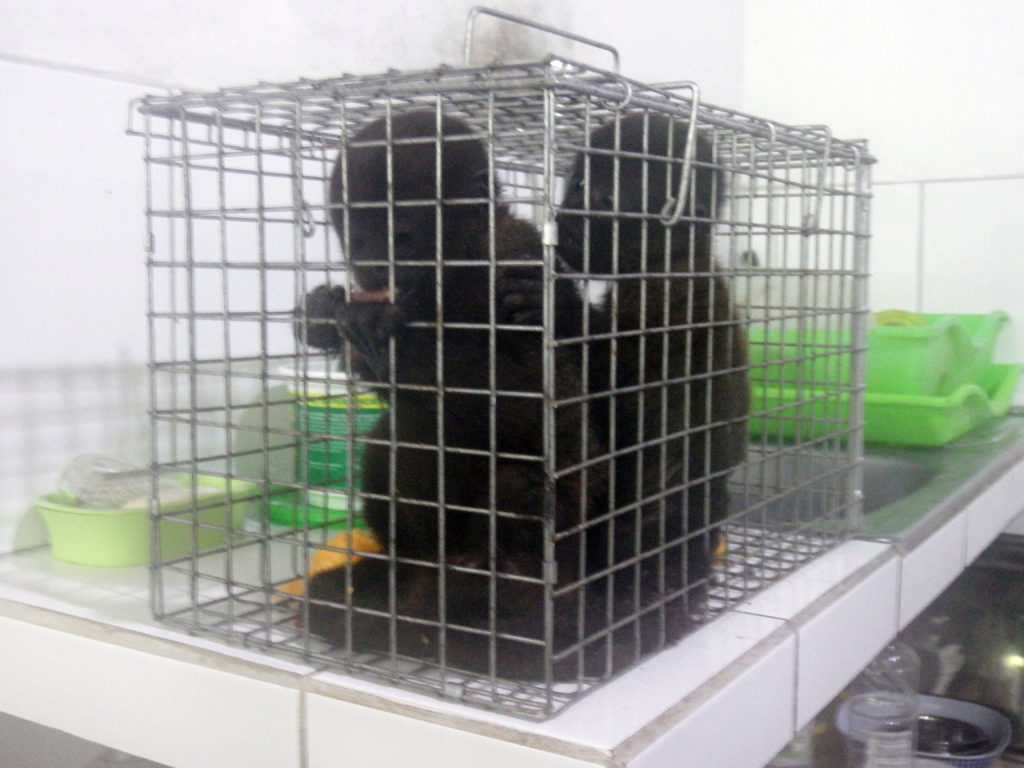
Mashi and Almira, male and female woolly monkeys, very young. Almira is playful and estimated about 8-9 months old and is already happily playing with the capuchins. Mashi is about 6 months and very skinny. He sleeps separately at night in a small cage, while spending some time during the day with the capuchins and Almira, as well as spending some time with a volunteer to stimulate him to eat and teach him what he should eat.
Maru, a juvenile male Ma’s night monkey, a very curious species. He will be a nice future companion for our outside night monkeys Luna and Otis.

Fonzo, a very young male capybara stole every ones heart immediately, as he happily greets anyone entering the treatment room. Yes we had to make use of all the space in the clinic this busy time.
Mastina, young female agouti, is the one of this group that is less tame. She is in good health, and resides in the cage that once was made for a Paka, under the long-term volunteer cabin.
These animals were all seized from a tourism venture that had no idea of how to look after them and what their needs were from day to day. Most of them are very young and underweight and many have underlying issues yet to be diagnosed.
This is a great reminder to anyone that if you stay at a hotel that has animals as an attraction you are supporting the illegal wildlife trade. Most of these animals have come from the illegal market and were captured from the wild for profit.
Complain to management and then if you are able, leave and find somewhere else to stay that does not support animal trade.
 Construction and other
Construction and other
As mentioned above we saw a great deal of moving and shuffling of animals and enclosures. The work involved in cleaning and building up each enclosure to suit particular animals is considerable and soaked up a lot of the available construction time.
Other projects that gained momentum this month was the beginning of cement beams for a replacement bridge that is needed between the Volunteer kitchen and the Bodega. Likewise efforts were focussed on taking more bricks to the new quarantine.
Although work on the quarantine has appeared to slow, we should see the completion of the brickwork in the next eight weeks, giving the workers a change of pace with the next stage of construction beginning.
 Volunteers
Volunteers

Another quiz night between the volunteers happened this month which may well be testament to how much the last one was enjoyed. This time the entire family of Olivia, Douwe, Kayla and Marlon was to join the volunteers for a hearty roast before beginning the challenge. There were only three randomly selected teams, and it was a draw for first place. Bragging rights were to be had by none, but a lot of sarcasm was to follow for the next few days for the team that lost. Olivia was at the helm of the losing team and as punishment the entire team was sent out in the dark to “test” the electric fence around Arana. Childish you may say, but incredibly satisfying if you were on the winning teams watching.
San Juan, a local celebration of a saint took place this month, all of the volunteers were treated to a lunch down at the waterfall where lunch was supplied and is representative of the head of the saint. A great time was had by all, and the perfect weather and company made for a very pleasant atmosphere.
We all await what challenges and celebrations are to evolve during July.



